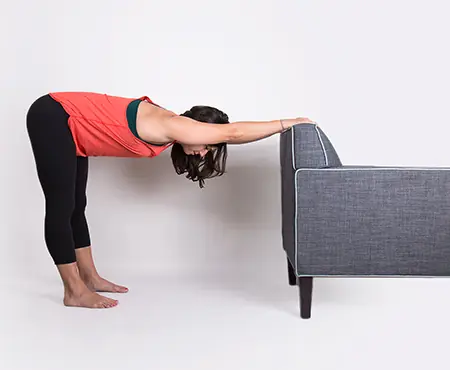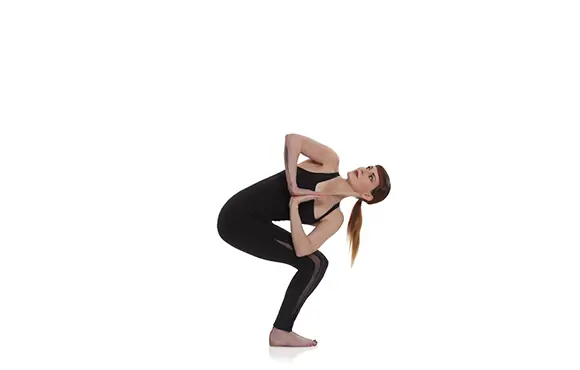We love to travel for so many reasons: Exploring different cultures, taking a break from our inbox, and actually relaxing a little are just a few. One part we don't particularly enjoy? Feeling super cramped and uncomfortably sandwiched between strangers (who somehow always seem to have a very unhappy baby or a hacking cough) on long flights, train rides, or road trips.
While we can't help with your unfortunate seatmates, we can offer a way counteract all that sitting. The following yoga poses help relieve an achy back, open up hip flexors, and even provide a mini-workout while you're on the go. They'll bring blood flow back to your head, legs, and all those body parts that fell asleep.
The best part: You don't need any equipment, so you can perform these moves anywhere your travels take you—a hotel room, the corner of an airport terminal, or even at a highway rest stop. Just be sure to stash some hand sanitizer in your suitcase.
1. Half Dog (Ardha Adho Makha Svanasana)
1 of 11
Photo Credit: Greatist
Place your fingertips on the wall at hip-height. Walk your feet back and bend from your hips until your legs and torso form a 90-degree angle with the floor, ankles directly underneath your hips.
Benefits: Opens your chest, shoulders, back, and hamstrings.
Perfect for: Relieving lower back pain after hours spent sitting in an uncomfy plane, bus, or train seat.
2. Chair Pose (Utkatasana)
2 of 11
Photo Credit: Greatist
Bring your feet together or hip-width apart. Reach your tailbone toward the floor, back straight, as you sit into an imaginary chair. Reach your fingertips toward the ceiling. Gaze upwards, drawing your head back.
Benefits: Strengthens your shins, legs, glutes, core, and arms.
Perfect for: Waking up all those parts of your body that don't get enough blood flow when you're strapped into a seatbelt.
3. Standard Hip Opener / Quad Stretch
3 of 11
Photo Credit: Greatist
Stand one to two feet away from a sink or chair. Bend one leg, reach the top of your foot behind you to rest on the surface. Draw your hips forward, holding onto the surface. Make sure hips stay level. Repeat on other leg.
Benefits: Stretches your quads, opens your hip flexors.
Perfect for: Lengthening tight hip flexors and quads. Also gets blood flow to the knee joint.
4. Tree Pose (Vrksasana)
4 of 11
Photo Credit: Greatist
Planting one foot firmly on the floor, bring the bottom of the other foot to the inside of the standing leg's calf or upper thigh. Keep a wall within reach in case you need it for balance. Switch legs and repeat.
Benefits: Improves balance, opens your hips, engages your core, improves ankle stability and foot arch strength.
Perfect for: Stretching and strengthening the back and side of your leg (and core) that get stiff during long commutes.
5. Standing Big Toe Pose (Utthita Hasta Padangustasana)
5 of 11
Photo Credit: Greatist
Plant your left foot on the floor and straighten your left leg. Shift your weight onto it. Lift your right leg off the floor. Bend at the right knee. Reach down with your right hand to grasp the big toe of your right foot (or the outside of your right foot). While holding onto a wall, extend that right leg straight out in front of you. Modify this by drawing the right knee into the chest with your right inner elbow. Repeat on other leg.
Benefits: Improves balance, engages the core, stretches the hamstring and lower back.
Perfect for: Stimulating parts of your brain that control balance.
6. Forward Bend (Uttanasana)
6 of 11
Photo Credit: Greatist
Place both feet firmly on the floor and place your fingertips or palms next to the outer edge of each foot. Pull your torso forward for a serious stretch. (If touching the floor makes you squeamish, simply grasp your calves to pull your torso forward.)
Benefits: Stimulates blood flow to the brain, stretches the hamstrings and lower back, lengthens and take stress off the spine.
Perfect for: Relieving back pain from uncomfy seating positions.
7. Standing Split (Urdhva Prasarita Eka Padasana)
7 of 11
Photo Credit: Greatist
From your glorious forward bend, lift one leg up the wall or the door to intensity the stretch. Keep the standing leg straight and your fingertips on the floor for balance. (Skip this pose if you'd rather not touch the floor.) Repeat on other leg.
Benefits: Deepens the hamstring stretch and opens your hip flexors.
Perfect for: Testing your flexibility, stretching your legs, and sending a bit more blood to the brain.
8. Half Moon Pose (Ardha Chandrasana)
8 of 11
Photo Credit: Greatist
Place your right fingertips on the floor (again, skip it if you're squeamish!). Your right toes should face forward. Lift your left leg, keeping your torso turned toward the wall. Reach your left arm toward the ceiling. Keep the standing right leg straight, without hyperflexing the knee. Repeat on other side.
Benefits: Improves balance, engages the core, stimulates leg muscles.
Perfect for: Waking up sleepy legs and brains.
9. Extended Side Angle (Parsvakonasana)
9 of 11
Photo Credit: Greatist
Lower your lifted leg from half moon (or sugarcane) pose, reaching back with the heel and bending the front knee. Stack your front knee above your right ankle—you should be able to see your big toe. Point the toes of your back foot forward. Lengthen your torso, placing your forearm on your front quad for support. Reach your top arm overhead, opening your chest to the ceiling.
Benefits: Opens the inner thighs, stretches the hip flexors, strengthens the quads, opens the torso, stretches the lats, improves core stability.
Perfect for: Relieving low back pain from sitting, saving leg muscles from stiffness.
10. Warrior II (Virabhadrasana II)
10 of 11
Photo Credit: Greatist
From extended side angle, shift your torso back to vertical, facing the wall. Reach your arms away from the torso, sinking your hips deeper. Draw your navel to your spine and gaze beyond the fingertips of your front hand.
Benefits: Opens inner thighs, strengthens quads and calves, improves ankle and core stability, stimulates slow-twitch fibers in shoulders and torso.
Perfect for: Getting some freedom from those strangers you're sandwiched between.
Get ACTIVE on the Go


Couch to 5K®
The best way to get new runners off the couch and across the finish line of their first 5K.
Available for iOS | Android






Discuss This Article